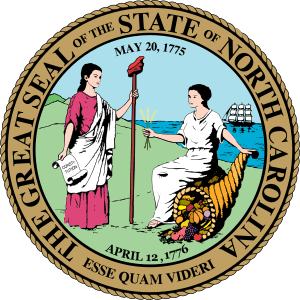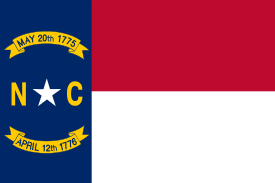Iredell County, North Carolina
Iredell County is a county located in the U.S. state of North Carolina. According to US Census projections in 2018, the population was 178,435. Its county seat is Statesville, and its largest town is Mooresville. The county was formed in 1788, annexed from Rowan County. It is named for James Iredell, one of the first justices of the Supreme Court of the United States.[1][2][3][4]
Iredell County | |
|---|---|
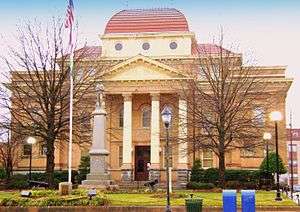 Iredell County Courthouse in Statesville | |
 Seal | |
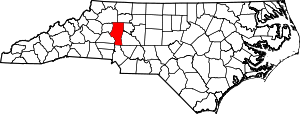 Location within the U.S. state of North Carolina | |
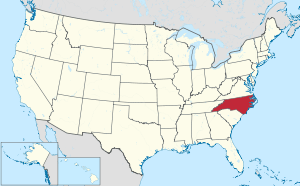 North Carolina's location within the U.S. | |
| Coordinates: 35°49′N 80°52′W | |
| Country | |
| State | |
| Founded | 1788 |
| Named for | James Iredell |
| Seat | Statesville |
| Largest town | Mooresville |
| Area | |
| • Total | 597 sq mi (1,550 km2) |
| • Land | 574 sq mi (1,490 km2) |
| • Water | 23 sq mi (60 km2) 3.9%% |
| Population | |
| • Estimate (2019) | 181,806 |
| Time zone | UTC−5 (Eastern) |
| • Summer (DST) | UTC−4 (EDT) |
| Congressional districts | 10th, 13th |
| Website | www |
Iredell County is included in the Charlotte–Concord–Gastonia, NC–SC Metropolitan Statistical Area, as defined in 2013 by the Office of Management and Budget with data from the U.S. Census Bureau.[5]
Historical timeline
Prior to colonization, three Siouan-speaking tribes associated with a culture group called the Eastern Siouans probably inhabited the area that is now Iredell County. Broken into several smaller tribes, they were the Catawba, the Waccamaw Siouan, the Cheraw, the Winyaw, the Wateree and the Sugaree. The following list shows significant events and firsts in the history of the area that is now called Iredell County, North Carolina.[3][6][7][8][9]
- 1629–1712, Province of Carolina ruled by Lords Proprietors under British rule
- 1712–1776, Province of North Carolina and Province of South Carolina created from Province of Carolina
- 1734, Bladen County formed from New Hanover County
- 1730–1750 first Scots-Irish and German immigrants seeking good soil, game, and proximity to freshwater had settled the area of modern-day Iredell County[3]
- 1750, Anson County formed from Bladen County
- 1750–1776, Lord Granville and later his son issued Granville Grants of land in the Granville District, which included the area that later became Iredell County but was then Anson and later Rowan Counties[10]
- 1750, Fourth Creek Congregation established
- 1753, Rowan County created from a portion of Anson County
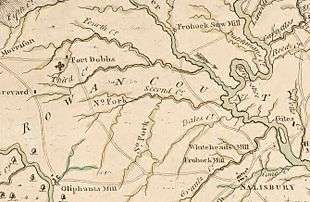
- 1754–1763, Fort Dobbs (named after Governor Arthur Dobbs) was erected as a defense facility during the French and Indian War (1754–63). Today, the location of Fort Dobbs is a North Carolina State Historic Site.
- 1761, Coddle Creek Associate Reformed Presbyterian Church, Session House and Cemetery established in what became Mooresville
- 1765, Centre Presbyterian Church established in what became Mooresville
- 1773, William Sharpe creates map of 4th Creek Congregation
- 1775, Bethany Presbyterian Church (north of Fourth Creek on Fifth Creek) and Concord Presbyterian Church (west of Fourth Creek) established as off-chutes of the Fourth Creek Congregation[7]
- 1775, Aug 1, Rowan County Regiment, North Carolina Militia established; most Iredell residents that saw service while in North Carolina, served in this Regiment; for a time in 1775 and 1782 the Regiment was divided into 1st and 2nd Rowan County Regiment[12]
- 1775–1783, North Carolina contributed 30,000 to 36,000 men to the Revolutionary War, including the Continental Army, local North Carolina County Regiments of militia, and other State Troops[12]
- 1776, Jul 4 United States Declaration of Independence
- 1777, State of North Carolina began issuing State Land Grants from land that came from Lord Granville estate in the Granville District[13]
- 1778, Aug, Adlai Osborne compiles Tax List of Rowan County to raise money for the upcoming Revolutionary War, including Capt Caldwell's, Capt Nichols', Capt Falls', and Capt Purviance's Districts that would become part of Iredell County in 1788[14]
- 1780, Jun 20, Battle of Ramsour's Mill nearby in what is today Lincolnton, North Carolina, many Rowan County soldiers were killed at this battle
- 1787, New Sterling ARP Church established in Buffalo Shoals area that would become New Sterling[15]
- 1788, Nov 3, Iredell County was incorporated in 1788 when it was formed from adjacent Rowan County. It is named for Honorable James Iredell, Sr. (1751–1799), Attorney General of North Carolina during the Revolutionary War, Supreme Court Justice, and a delegate to the Constitutional Convention of 1788. Its county seat is Statesville.
- 1789, November 21, North Carolina admitted to the Union as the 12th state
- 1789, Fourth Creek Congregation location chosen by the legislature as county seat of Iredell County, named Statesville
- 1790s, McKendree United Methodist Church established in Mooresville
- 1790, Aug 13, first 26 lots sold in Statesville
- 1794, Grassy Knob Baptist Church established near what would become Union Grove in northern Iredell County
- 1800, US Census shows 11 heads of household, including 68 free white persons and 27 slaves in "States Ville"
- 1801, first post office established in Statesville
- 1805, Mount Mourne post office established
- 1819, 2nd County Courthouse built in Statesville
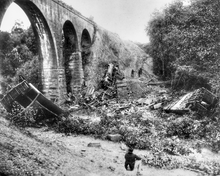
- 1847, The only major cession of Iredell territory to another county was that to Alexander County, created in early 1847 from Iredell, Burke, and Wilkes counties.
- 1854, fire burns 2nd County Courthouse and court house records
- 1858, The arrival of the Western North Carolina Railroad in 1858, soon followed by the Atlantic, Tennessee and Ohio Railroad
- 1861–1865, US Civil War
- 1866, Freedom United Presbyterian Church and Logan Presbyterian Church, first free black churches, established in Statesville[16]
- 1868, May 1, Tom Dooley hung in Statesville
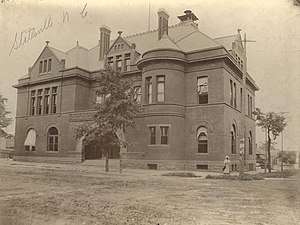
- 1891, Aug 27, The railway accident on the Bostian Bridge killed 23 people on August 27, 1891, west of Statesville, North Carolina, when a Richmond & Danville Railroad train derailed.[17]
- 1891 third U.S. Post Office and County Courthouse built in Statesville
- 1899, fourth Iredell County Courthouse built in Statesville
- 1900s, Industries producing tobacco, liquor, and herbs (Statesville's Wallace Herbarium was one of the largest such facilities in the world during the late 19th and early 20th centuries) were later supplemented by the production of livestock, dairy products, and breeder chickens, of which the county remains a leading producer.
- 1924, Ole Time Fiddlers' Convention in Union Grove started by H.P. VanHoy to benefit local school
- 1974, about, National Balloon Rally/Fest in Troutman
- The North Carolina Auto Racing Hall of Fame in Mooresville (known as "Race City USA")
- 1954, cowboy town of Love Valley created by Jeter Andrew Barker
Geography
According to the U.S. Census Bureau, the county has a total area of 597 square miles (1,550 km2), of which 574 square miles (1,490 km2) is land and 23 square miles (60 km2) (3.9%) is water.[18]
Iredell County is located within the Piedmont Region of central North Carolina. The northwestern section of the county contains the Brushy Mountains, a deeply eroded spur of the Blue Ridge Mountains far to the west. The highest point in Iredell County, Fox Mountain, is in the Brushies; it rises to 1,760 feet. Although the "Brushies", as they are often called locally, are not high in the normal sense, they do rise prominently above the surrounding countryside. The remainder of Iredell County consists of gently rolling countryside occasionally broken by low hills and small river valleys. The county's largest river, the Catawba, forms much of its western border. Lake Norman, North Carolina's largest manmade lake, is the most prominent geographic feature of southern Iredell County; it is often called North Carolina's "inland sea".
Iredell County is an important transportation center for the state, as Interstate 77 and Interstate 40 cross in northeast Statesville. This has given birth to the county's slogan "Crossroads for the Future." Residents have easy access going south on I-77 to Charlotte; north on I-77 to Elkin, North Carolina and Roanoke, Virginia; east on I-40 to Winston-Salem, Greensboro and Raleigh; and west along I-40 to Hickory, North Carolina and Asheville.
The northern third of Iredell county is highly rural and contains no large towns. Due to the thinly populated nature of this portion of the state, it is one of the select places in North Carolina where the speed limit on Interstate Highways exceeds 65 mph, as Interstate 77 north of Statesville has a speed limit of 70 mph.
Iredell County is one of the longest counties in the state and stretches for nearly fifty miles north to south from Yadkin County in the north to Mecklenburg in the south.
Adjacent counties
- Yadkin County – north (created from Surry County in 1850)
- Davie County – east (created from Rowan County in 1836)
- Rowan County – east (created from Anson County in 1753)
- Cabarrus County – southeast (created from Mecklenburg County in 1792)
- Mecklenburg County – south (created from Anson County in 1762)
- Lincoln County – southwest (created from Tryon County in 1779)
- Catawba County – southwest (created from Lincoln County in 1842)
- Alexander County – west (created from Caldwell, Iredell, and Wilkes Counties in 1847)
- Wilkes County – north (created from Surry County and parts of Washington District in 1777)
City
- Statesville (county seat, established in 1789)[7][8]
Towns
Census-designated places
- Stony Point (town in both Alexander and Iredell Counties, Post Office established in 1826)[7][8]
Unincorporated communities
As of 2019, the unincorporated communities in the county include:[7][8]
- Amity Hill (Post Office established in 1851)
- Barium Springs (Post Office established in 1889)
- Houstonville (Post Office established in 1813)
- Mount Mourne (Post Office established in 1805)
- Olin (Post Office established in 1856)
- Scotts (Post Office established in 1894, called Scott's Crossroads in 1873)
- Turnersburg (Post Office established in 1858, originally called Turnersburgh)
- Union Grove (established in 1867)
Townships
By the requirements of the North Carolina Constitution of 1868, the county was divided into townships. Previous to that time, the subdivisions were Captain's Districts. While the Captain's Districts referred primarily to the militia, it served also for the election precinct, the tax listing and tax collecting district.[19][14] The following townships were created in 1868:[7][8]
Historical populated places
In the 1700s and 1800s, before there were many towns in what became Iredell County, property was identified by stream, rivers, or adjacent landowners. The following is a list of the streams, rivers, and creeks in Iredell County.[7][8]
- Back Creek (R)
- Bear Branch
- Beaver Dam Creek (R)
- Brotherton Branch
- Brushy Creek
- Buffalo Branch
- Buffalo Shoals Creek/aka 8 Miles Shoals Creek
- Catawba River
- Cavin Creek
- Coddle Creek (R)
- Davidson's Creek (M)
- Drop Off Creek
- Duck Creek
- Dutchman's Creek
- Elk Shoal's Creek
- Eupetic Springs
- Five Mile Branch
- Fourth Creek (R)
- Glade Creek
- Gregory Branch
- Hunting Creek
- Island Creek
- Kerr Branch
- Knowden's Ford
- Little Dutchman's Creek
- Little River
- Little Rocky Branch
- Long Branch
- North Fork of the Yadkin River
- Norwood(s) Creek[2]
- Oil Mill Branch
- Old Camp Creek
- Old House Creek
- Olin Creek, aka Middle Fork of Rocky Creek
- Porter's Branch
- Rock Cut, Deep Cut
- Rocky Creek
- Rocky River (M)
- South Branch
- South Fork of Grassy Creek, aka Yadkin River
- South Yadkin River (A)
- Speaks Creek
- Third Creek (R)
- Turkey Foot Branch
- West Rocky River (M)
- Withrow's Creek (R)
- Yadkin River (R) (D)
- Young's Creek
- (R)--Portions in Rowan County
- (D)--Portions in Davie County
- (M)--Portions in Mecklenburg County
- (A)--Portions in Alexander County
The table below lists towns and post offices (PO) that no longer exist or that were once in Iredell County but are now in another county:[7][6]
| Historical Populated Places (date range) |
|---|
| A Abernathy PO (1891–1903), Adams PO (1892–1901), Allison's PO (1831–1832), Amity Hill PO (1851–1892), Amity PO (1892–1906), Armfield PO (1881–1902), B Banton PO (1892–1905), Bell's Crossroads, Belt's Bridge PO (1858–1867), Bethany Church PO (1822–1880), Bogies PO (1826–1846), Boyden Post Office (1857–1861), Bradford Crossroads, Bryantsville Post Office, Buffalo, Buffalo Shoal PO, C Callahan, Campbell's Grove (1813–1824), Carstown, Catawba Station, Chestnut Grove PO (Catawba County, 1856–1859), Celestica Hinkle, Charles (1889–1951), Charles PO (1899–1951), Cherry Plains PO (1813–1815), Claud PO (1903–1905), Clio Post Office (1883–1902), Clover Bottom PO (1830–1835), Coddle Creek (1903–1915), Congers PO (1874–1880), Cool Springs PO (1852–1907), Crater's Mills PO (1851–1857), D Daltonia PO (1898–1905), Deep Well (1842–1866), Doolie PO (1881–1903), Dunlap (1893–1936), E Eagle City PO (1894–1907), Eagle Mills PO (1848–1894), East Monbo (1909–1925), Ebenezer, Elmwood (1878–1954), Enola PO (1858–1872), Eufola (1903–1943), Eupeptic Springs (1875–1905), Evalin PO (1884–1906), F Fallstown Post Office (1813–1866), Fancy Hill (aka Loray (1840–1903), Flake (1904–1905), Fort Dobbs (1755–1766), Fourth Creek Settlement (1750–1789), Friends Mill/Friends PO (1900–1907), Fulbright (1899–1912), G Garland (1886–1886), Goshen PO (1829–1842), Granite Hill PO (1857–1866, 1871–1895), Granitehill PO (1895–1903), Grassy Creek (1840–1841), Grassy Fork PO (1840–1841), Gratz PO (1900–1904), Guss PO (1888–1892), H Henderson's Cross Roads, Hilo PO (1900–1904), Houstonville PO (1813–1869, 1883–1955), J Jenning's Mills PO (1872–1892), K Kyle Crossroads, L Liberty Hill PO (1826–1880), Linker, Longford PO (1886–1907), Loray (aka Fancy Hill, 1840–1903), Lorn, M Malans PO (1902–1903), Map PO (1901–1902), Maple Bottom PO (1849–1851), Mayhew PO (1881–1905), Mazeppa PO (1900–1908), McCurdy PO (1879–1906), Miller PO (1883–1904), Mount Pleasant, Muddy Fork PO (1831–1834), Murdock PO (1880–1881), N Net PO (1894–1907), New Hope Forge PO (1827–1832), New Hope PO (1832–1894), New Institute PO (1852–1856), New Sterling PO (1858–1905), Newhope PO (1894–1955), Nicholson's Mills (1876–1905), Norfolk PO, Norwood, O Oak Forest PO (1837–1907), Oak Grove (1826–1828), Olin PO, Oswalt (1895–1927), P Perth PO (1889–1901), Poison Springs (1886–1889), Poplar Bridge (1861–1877), Poplar Grove PO (1829–1856), Post Oak PO (1850–1859), Pressly PO (1888–1903), R Reno PO (1875–1876), River Hill PO (1875–1907), Robinsons PO (1830–1831), Rock Cut PO (1859–1903), Rocky Creek PO (1827–1855), Rod PO (1899–1905), S Scott's Cross Roads (1873–1894), Settle PO (1873–1906), Sharon, Sharpesburg (1893–1903), Sharpesburg Township (1892–1893), Sheperd/Shepherds PO, Shiloh (1824–1829), Shinnville (1889–1905), Sigma (1891–1903), Simonton's Mills PO (1871–1871), Smith's Cross Roads (1832–1832), Snow Creek (1831–1903), Snow Creek Iron Works (1802–1825), Spring Grove PO (1827–1847), Spring PO (1898–1903), Staphel/Stophel PO (1898/1892–1901), Sullivan PO (1827–1831), Sweet Home PO, T Tabor Church PO (1828–1845), Talmadge PO (1900–1905), Thoma's Ferry (1828–1831), Trip PO (1901–1903), Turner's Store PO (1831–1844), Turnersburgh (1858–1894), V V Point, Vance PO (1882–1901), W Watts PO (1891–1903), Waugh PO (1887–1901), Weisner PO (1886–1903), Wildwood Park, Williamsburg PO (1818–1827), Williamsburgh PO (1832–1905) |
| Former Iredell County Towns that are now part of other counties (county, period that they were in Iredell) |
| Catawba Station (Catawba, 1856–1859), Elk Shoal (Alexander, 1875–1881), Evalin (Wilkes, 1884–1906), Grade (Alexander, 1882–1883), James Cross Roads PO (Alexander, 1831–1847), Hiddenite (Alexander, d. 1849), Mount Pisgah (Alexander, 1817–1849), Spring Grove (Rowan, 1818–1847, 1855–1883), Stony Point (Alexander, 1826–1849), Taylorsville (aka James Cross Roads, Alexander, 1847–1847), Tulin (Cabarrus, 1856–1870), Zion (Yadkin, 1830–1856) |
Demographics
| Historical population | |||
|---|---|---|---|
| Census | Pop. | %± | |
| 1790 | 5,430 | — | |
| 1800 | 8,856 | 63.1% | |
| 1810 | 10,972 | 23.9% | |
| 1820 | 13,071 | 19.1% | |
| 1830 | 14,918 | 14.1% | |
| 1840 | 15,685 | 5.1% | |
| 1850 | 14,719 | −6.2% | |
| 1860 | 15,347 | 4.3% | |
| 1870 | 16,931 | 10.3% | |
| 1880 | 22,675 | 33.9% | |
| 1890 | 25,462 | 12.3% | |
| 1900 | 29,064 | 14.1% | |
| 1910 | 34,315 | 18.1% | |
| 1920 | 37,956 | 10.6% | |
| 1930 | 46,693 | 23.0% | |
| 1940 | 50,424 | 8.0% | |
| 1950 | 56,303 | 11.7% | |
| 1960 | 62,526 | 11.1% | |
| 1970 | 72,197 | 15.5% | |
| 1980 | 82,538 | 14.3% | |
| 1990 | 92,931 | 12.6% | |
| 2000 | 122,660 | 32.0% | |
| 2010 | 159,437 | 30.0% | |
| Est. 2019 | 181,806 | [20] | 14.0% |
| U.S. Decennial Census[21] 1790–1960[22] 1900–1990[23] 1990–2000[24] 2010–2014[1] 1810–1850[25] | |||
As of the census[26] of 2010, there were 159,437 people, and 59,593[27] households in the county. The population density was 277.8[27] people per square mile (82/km²). As of 2013 there were 69,325[27] housing units at an average density of 90 per square mile (35/km²). The racial makeup of the county was 83.3% White, 12.3% Black or African American, 0.5% Native American, 2.2% Asian, 0.1% Pacific Islander, 1.68% from other races, and 1.6% from two or more races. 7.0% of the population were Hispanic or Latino of any race.
According to the 2000 census data, there were 47,360 households out of which 33.5% had children under the age of 18 living with them, 57.8% were married couples living together, 11.3% had a female householder with no husband present, and 26.8% were non-families. 22.7% of all households were made up of individuals and 8.4% had someone living alone who was 65 years of age or older. The average household size was 2.56 and the average family size was 3.00.
In the county, the population was spread out with 25.5% under the age of 18, 7.5% from 18 to 24, 31.3% from 25 to 44, 23.3% from 45 to 64, and 12.4% who were 65 years of age or older. The median age was 36 years. For every 100 females there were 96.1 males. For every 100 females age 18 and over, there were 93.1 males.
As of 2013,[27] the median income for a household in the county was $50,058. Males had a median income of $34,590 versus $24,031 for females. The per capita income for the county was $26,348.[27] About 6.2% of families and 13.5%[27] of the population were below the poverty line, including 10.1% of those under age 18 and 9.8% of those age 65 or over.
Current politics, law and government
Iredell County is governed by the Board of Commissioners, consisting of five commissioners elected at-large, which requires each to attract a majority of the votes.[28]
The Iredell County Commissioners (2016–present) are James Mallory (Chairman), Marvin Norman, Tommy Bowles, Jeff McNeely and Gene Houpe, all Republicans.[28]
Iredell County is a member of the Centralina Council of Governments.[29]
The Sheriff of Iredell County is Darren E. Campbell (Republican), elected in December 2014. He succeeded Phillip Redmond, who was first elected in 1994.[30]
The Register of Deeds of Iredell County is Ronald "Duck" Wyatt (Republican), appointed in 2016. The Register of Deeds serves as custodian and manager of a large number of land records and vital records.[31]
Iredell County is part of prosecutorial District 22A with Alexander County. The Iredell County Courthouse is located in the county seat of Statesville, North Carolina. The District Attorney is Sarah Kirkman.[32]
The Senior Resident Superior Court Judge is Joe Crosswhite. The Chief District Court Judge is Dale Graham. James Lee (Jim) Mixson III has served as Iredell County's Clerk of Superior Court since 2012. Clerks of Superior Court in North Carolina also serve as Probate Judges in addition to their administrative duties.[33]
Since 1952, Iredell county voting records show a strong Republican majority. Before 1952, however, Iredell was part of the Democratic "Solid South" and voted for no Republican presidential candidate after Reconstruction except Herbert Hoover in 1928. In 1964, the year that national civil rights legislation was passed, it was one of 13 North Carolina counties to vote for Barry Goldwater. In the past 17 elections, the only Democrat to carry Iredell County was Jimmy Carter in 1976, who was a native son of Georgia and the South.[34]
| Year | Republican | Democratic | Third parties |
|---|---|---|---|
| 2016 | 66.3% 54,754 | 30.0% 24,734 | 3.7% 3,079 |
| 2012 | 64.6% 49,299 | 34.2% 26,076 | 1.3% 990 |
| 2008 | 61.7% 45,148 | 37.3% 27,318 | 1.0% 696 |
| 2004 | 67.9% 38,675 | 31.7% 18,065 | 0.4% 233 |
| 2000 | 65.5% 29,853 | 33.9% 15,434 | 0.7% 299 |
| 1996 | 56.6% 21,163 | 35.0% 13,102 | 8.4% 3,144 |
| 1992 | 49.8% 19,411 | 34.0% 13,263 | 16.2% 6,306 |
| 1988 | 67.0% 21,536 | 32.8% 10,530 | 0.2% 69 |
| 1984 | 70.1% 23,641 | 29.7% 9,999 | 0.2% 64 |
| 1980 | 53.7% 14,926 | 43.4% 12,067 | 2.9% 801 |
| 1976 | 46.1% 11,573 | 52.9% 13,295 | 1.1% 263 |
| 1972 | 73.8% 16,736 | 22.4% 5,088 | 3.8% 858 |
| 1968 | 43.2% 10,557 | 20.0% 4,878 | 36.9% 9,021 |
| 1964 | 53.4% 12,892 | 46.6% 11,231 | |
| 1960 | 57.4% 12,085 | 42.6% 8,973 | |
| 1956 | 60.4% 11,125 | 39.6% 7,286 | |
| 1952 | 57.9% 11,804 | 42.1% 8,580 | |
| 1948 | 36.6% 4,441 | 47.5% 5,761 | 15.9% 1,934 |
| 1944 | 36.8% 4,864 | 63.2% 8,358 | |
| 1940 | 27.0% 3,820 | 73.0% 10,328 | |
| 1936 | 25.2% 3,817 | 74.8% 11,308 | |
| 1932 | 29.9% 3,583 | 69.7% 8,367 | 0.5% 55 |
| 1928 | 58.1% 6,712 | 41.9% 4,836 | |
| 1924 | 35.1% 3,565 | 63.5% 6,449 | 1.3% 136 |
| 1920 | 40.5% 4,402 | 59.5% 6,470 | |
| 1916 | 38.3% 2,073 | 61.7% 3,335 | |
| 1912 | 9.9% 392 | 63.7% 2,528 | 26.4% 1,049 |
Economy
Farming is still a major source of income for many Iredell County residents. Dairy farming has been particularly popular in Iredell County since the early 1800s, in both the northern and southern sections of the county. However, the rapid population growth and development in southern Iredell County is putting increasing pressure on farmlands, and many farms in this section are giving way to shopping centers, housing developments, and large corporate office parks.[7]
Iredell County is a major hub of NASCAR racing, with many race shops located in the county (mostly around Mooresville). Universal Technical Institute operates NASCAR Technical Institute under licensing agreements. The school offers racing-related instruction to prepare the student for their job search in the racing industry. Many NASCAR drivers live around Mooresville and Lake Norman. Although northern Iredell County has retained much of its rural character, the southern half of the county is experiencing rapid suburbanization and population growth, largely due to the immense popularity of the Lake Norman area for residents of nearby Charlotte, North Carolina's largest city.
Education
The county is served by two traditional public school districts: Iredell-Statesville Schools (ISS) and Mooresville Graded School District (MGSD). The county is also served by several public charter schools[36]
Iredell Statesville School District
The following schools were in the Iredell—Statesville School District as of 2018:[37]
- High Schools: Collaborative College for Technology and Leadership[38] at Mitchell Community College, Career Academy and Technical School, Lake Norman High School, Monticello (combined elementary, middle, and high school, 4–12), North Iredell High School, Pressly (combined elementary, middle, and high school, K–12), South Iredell High School, Statesville Senior High School, Visual and Performing Arts Center at Statesville High at Statesville High School, West Iredell High School, Mount Mourne IB (combined middle and high schools, 6–8, 9–12 is at South Iredell High School), Northview IB (combined middle and high schools, 6–8, 9–12 is at South Iredell High School)
- Middle Schools: Brawley, East Iredell, Lakeshore, North Iredell, Statesville, Troutman, West Iredell
- Elementary Schools: Celeste Henkel, Central, Cloverleaf, Coddle Creek, Cool Spring, East Iredell, Harmony, Lake Norman, Lakeshore, N. B. Mills, Scotts, Sharon, Shepherd, Third Creek, Troutman, Union Grove, Woodland Heights
Mooresville Graded School District
The following schools were in the Mooresville Graded School District, as of 2018:[37]
- High Schools: Mooresville Senior High, N.F. Woods Advanced Technology and Arts Center
- Middle Schools: Mooresville Intermediate, East Mooresville Intermediate, Mooresville Middle
- Elementary Schools: Park View Elementary, South Elementary, Rocky River Elementary
Public charter schools
The following public charter schools existed in 2018:[37]
Private schools
Higher education
The following current and historical institutions of higher education were located in Iredell County:[7]
- Clio's Nursery of Arts and Sciences (1778)[44][45]
- Concord Female Seminary, Female Seminary in Statesville (1832)[46]
- Crowfield Academy (operated from 1760–1788)[47]
- Ebenezer Academy (1821)
- Mitchell College, Statesville: Mitchell Community College was originally founded in 1856 in Statesville, North Carolina, as Concord Female College. The school was purchased by Robert and Roxanna Simonton around 1872 and renamed Simonton Female College. It became Mitchell College in 1917.
- Olin High School (1857)
- Snow Creek Academy (1849)
- Statesville/Clio Academy, Muschat's Academy (1814)
Transportation
Railroads
Iredell County is served by two railroads, Alexander Railroad and Norfolk Southern Railway.
Notable people
- Jeter Andrew Barker, Jr. (1924–2011), military veteran, contractor, philanthropist, and founder of the old-west town Love Valley[7]
- Hutchins Gordon Burton (aft. 1774–1836), 22nd Governor of North Carolina, died while visiting relatives in Iredell County[7]
- Thomas C. "Tom" Dula aka Dooley (1848–1868), tried, convicted, and hanged for murder in Statesville, North Carolina[7]
- Bobby Dale Earnhardt (b. 1987), NASCAR racing driver
- Rev. James Hall, D.D. (1744–1826), Presbyterian minister
- Edward Harris (1763–1813), lawyer, politician and judge
- James Iredell, Sr. (1750–1799), County namesake[7]
- Mildred Maxine (Jenkins) Miller (1932–2011), local historian, author, and President of the Genealogical Society of Iredell County[8][9]
- Homer Maxwell Keever (1905–1979), local teacher, historian and author[7]
- Rev. Mussenden Ebenezer Matthews (abt. 1751–1830), revolutionary Lieutenant, Presbyterian minister, and politician[48]
- Anderson Mitchell (1800–1876), US Congressman from North Carolina[7]
- Col Adlai Osborne (1744–1814), lawyer, public official, plantation owner, educational leader, Revolutionary War officer of the 2nd Rowan County Regiment
- Rufus Reid (planter) (1797–1854), planter and builder of Mount Mourne plantation, politician[7]
- William Sharpe (1742–1818), Revolutionary War patriot, lawyer, politician, author of the Fourth Creek Congregation map in 1773[7]
- Adam Torrence, Sr. (1732–1780), Revolutionary War patriot killed at the Battle of Ramsour's Mill, owner of Torrence Tavern where the Battle of Torrence's Tavern took place[7]
- Wilfred D. Turner (1855–1933), ninth Lieutenant Governor of North Carolina
- Zebulon Baird Vance (1830–1894), Governor of North Carolina, lived and owned a home in Statesville (currently, a museum run by the DAR)[49]
See also
- National Register of Historic Places listings in Iredell County, North Carolina
- USS Iredell County (LST-839)
- Fort Dobbs (North Carolina) (located just north of Statesville)
- People from Iredell County, North Carolina
- Statesville Record & Landmark (local newspaper)
References
- "State & County QuickFacts". United States Census Bureau. Archived from the original on June 7, 2011. Retrieved October 21, 2013.
- "Find a County". National Association of Counties. Archived from the original on 2011-05-31. Retrieved 2011-06-07.
- Martin, Jonathan; "North Carolina History Project - Iredell County". Retrieved November 4, 2014.
- Gannett, Henry (1905). The Origin of Certain Place Names in the United States. Govt. Print. Off. pp. 165.
- Chesser, John (March 28, 2013). "Boundary change boosts Charlotte metro population". UNC Charlotte Urban Institute. Retrieved February 25, 2019.
- Lewis, J.D.; "Iredell County Towns with Post Offices". Retrieved January 31, 2019.
- Keever, Homer M. (November 1976). Iredell Piedmont County, with illustrations by Louise Gilbert and maps by Mildred Jenkins Miller. Iredell County Bicentennial Commission by Brady Printing Company from type set by the Statesville Record and Landmark.
- The Heritage of Iredell County, 1980, published by the Genealogical Society of Iredell County, PO Box 946, Statesville, North Carolina 28677, ISBN 0-89459-087-1, 642 pages with index
- The Heritage of Iredell County, NC Vol II, 2000, published by the Genealogical Society of Iredell County, PO Box 946, Statesville, North Carolina 29866, LC # 00-110956, 574 pages with index
- Land Records in North Carolina, see also Rowan and Iredell County Register of Deeds historical records
- "A Complete map of North Carolina from an actual survey". North Carolina Maps. UNC Digital Collections. Retrieved December 31, 2012.
- Lewis, J.D. (2012). NC Patriots 1775–1783: Their Own Words, Volume 1, 2, 3.
- "North Carolina Land and Property". Retrieved February 11, 2019.
- "List of taxable property in the county of Rowan, North Carolina, anno 1778 (transcribed from several lists returned by the August term anno 1778, also see page 30 for tax lists of 1784)". Retrieved Feb 6, 2019.
- Miller, Mildred. Peggy Byers Gray and Robert Ernest Mize (ed.). From Stirling to Sterling, the Bicentennial History of New Sterling Associate Reformed Presbyterian Church. 1987. The Delmar Company.
- Spencer, Preston; Statesville Record and Landmark; "Faith & Freedom: The history of Iredell's black churches". Retrieved February 1, 2014.
- Bill Moose: "Bostian Bridge Train Wreck". Retrieved February 5, 2019. In: Encyclopedia of North Carolina, edited by William S. Powell, 2006
- "2010 Census Gazetteer Files". United States Census Bureau. August 22, 2012. Archived from the original on January 12, 2015. Retrieved January 17, 2015.
- "North Carolina Constitution of 1868" (PDF). Retrieved May 19, 2019.
- "Population and Housing Unit Estimates". Retrieved March 28, 2020.
- "U.S. Decennial Census". United States Census Bureau. Retrieved January 17, 2015.
- "Historical Census Browser". University of Virginia Library. Archived from the original on August 11, 2012. Retrieved January 17, 2015.,, Archive index at the Wayback Machine
- Forstall, Richard L., ed. (March 27, 1995). "Population of Counties by Decennial Census: 1900 to 1990". United States Census Bureau. Retrieved January 17, 2015.
- "Census 2000 PHC-T-4. Ranking Tables for Counties: 1990 and 2000" (PDF). United States Census Bureau. April 2, 2001. Retrieved January 17, 2015.
- Fannings Illustrated Gazateer of the United States. New York: Phelps, Fanning and Company, 195 Broadway. 1853. p. 169. Retrieved August 21, 2019., Population: 1810, 10,972; 1820, 13,071; 1830, 15,262; 1840, 15,685; 1850, 14,718
- "U.S. Census website". United States Census Bureau. Retrieved 2008-01-31.
- "U.S. Census of 2010, Archived copy". Archived from the original on 2011-06-07. Retrieved 2011-07-06.
- "Iredell Board of Commissioners". Retrieved August 10, 2019.
- "Centralina Council of Governments". Retrieved August 10, 2019.
- "Campbell takes oath as new Iredell sheriff". statesville.com. Retrieved 5 March 2015.
- "Register of Deeds". co.iredell.nc.us. Retrieved December 28, 2019.
- "Your District Attorney". ncdistrictattorney.org. Retrieved December 30, 2019.
- "Joseph N. Crosswhite". ballotpedia.org. Retrieved December 30, 2019.
- Leip, David. "Dave Leip's Atlas of U.S. Presidential Elections". uselectionatlas.org. Retrieved 2018-03-16.
- "Form 10-K". www.sec.gov. February 1, 2019. Retrieved 6 June 2019.
- "School". ncpublicschools.org. Retrieved 2015-12-28.
- "Iredell-Statesville Schools web page". Archived from the original on 2011-02-08. Retrieved 2011-02-28.,
- "Collaborative College for Technology & Leadership". Retrieved 12 October 2012.
- "North Carolina High School Districts | Best High Schools". U.S. News & World Report. Retrieved 2015-12-28.
- "Langtree Charter Academy". Retrieved February 17, 2019.
- "American Renaissance School".
- "Iredell Charter Academy". Retrieved February 17, 2019.
- "Woodlawn School". Retrieved February 17, 2019.
- "Clio's Nursery, NC Historical Marker M-23". Retrieved February 17, 2019.
- "Troxler, George W., 2006". NCPedia. Retrieved February 17, 2019.
- Kelly Agan, Government & Heritage Library, 2014, 2016, 2017 (2010). "Davidson, Jennifer and Huaman, Jaime; Government & Heritage Library". Retrieved February 17, 2019.CS1 maint: multiple names: authors list (link)
- Hill, Michael (2006). "Crowfield Academy". NCPedia. Retrieved February 1, 2019.
- Rev. William Henry Foote (1794–1869) (1846). Sketches of North Carolina, Historical and Biographical, Illustrative of the Principles of a Portion of Her Early Settlers., accessed: February 7, 2019
- "Vance House". Retrieved Feb 14, 2019.
Bibliography
- Keever, Homer M.; Iredell Piedmont County, with illustrations by Louise Gilbert and maps by Mild red Jenkins Miller, published for the Iredell County Bicentennial Commission by Brady Printing Company from type set by the Statesville Record and Landmark, copyright, November 1976, by Homer M. Keever.
- The Heritage of Iredell County, 1980, published by the Genealogical Society of Iredell County, PO Box 946, Statesville, North Carolina 28677, ISBN 0-89459-087-1, 642 pages with index
- The Heritage of Iredell County, NC Vol II, 2000, published by the Genealogical Society of Iredell County, PO Box 946, Statesville, North Carolina 29866, LC # 00-110956, 574 pages with index
External links
- Iredell County government official website



